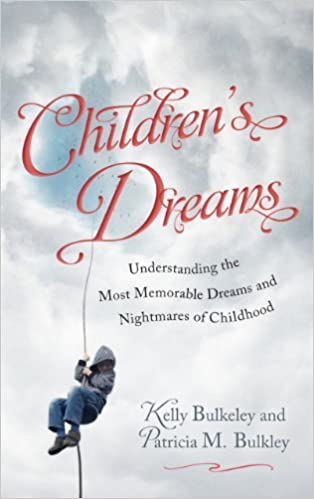 Children’s Dreams: Understanding the Most Memorable Dreams and Nightmares of Childhood (2012)
Children’s Dreams: Understanding the Most Memorable Dreams and Nightmares of Childhood (2012)
Description
When a child talks about a vivid nighttime dream, it can be difficult for adults to know how to respond. Dream researchers Kelly Bulkeley and Patricia Bulkley take readers beyond “it was just a dream” to help children and adults understand why we dream and how dreams can help us unlock our creativity and make sense of our lives. The book introduces readers to the basic psychology and neuroscience of dreaming, then explores dreams from early childhood through adolescence.
The book focuses on what psychologist C. G. Jung called the “big dreams” of childhood—intensely memorable dreams that can blaze themselves into children’s memories and remain a haunting, often inspiring, presence throughout their lives. While acknowledging that a complete interpretation of any dream requires personal input from the dreamer, the authors show readers how to identify recurrent patterns in dreams that reflect the primal wisdom and the healthy growth of every child’s mind and imagination. Children’s Dreams offers practical advice about how adults can best communicate with children about dreams to offer reassurance and to cultivate a child’s imagination and development.
Table of Contents
Introduction
1. Interpreting Children’s Dreams
2. Brain Science, Dreams, and the Imagination
3. Dreams of Early Childhood
4. Dreams of Middle Childhood
5. Dreams of Late Childhood and Early Adolescence
6. Nurturing the Imagination in Childhood and Beyond
Appendix 1: A List of the Dreams Discussed in this Book
Appendix 2: Children’s Stories Relating to Dreams
Appendix 3: The Dreams and Nightmares of Harry Potter
Appendix 4: Activities to Stimulate Wonder in Childhood
Appendix 5: Questions for a Study Group or Book Club on Children’s Dreams
References and Suggested Readings
Index
About the Authors
Comments and Reviews
“Dream researchers Kelly Bulkeley and Patricia Bulkley incorporate Carl Jung’s dream psychology in their new book to help children and adults understand why we dream and how dreams can unlock our creativity and make sense of our lives. Introducing readers to the basic psychology and neuroscience of dreaming, and offering analysis of several children’s dreams, this intriguing guide offers practical advice for adults to communicate better with children about their dreams, and how they can cultivate a child’s imagination.” (ForeWord Reviews )
The authors (Dreaming Beyond Death) clearly state their mission in writing this book: to remedy the dearth of information children receive today about dreams and understand their dreaming experience. They also want to help parents, teachers, and other caregivers to respond to children’s conversations about their dreams as “an experience of emotional truth” and to help children use dreams to develop their powers of imagination. To that end, the authors offer a brief primer on Jungian concepts like “collective unconscious” archetypes. The book takes a more engrossing turn when relating authentic dreams and their interpretations, including fanciful dreams like “My good monster angel” (who fights the bad monster in a boy’s dream) or “the girl of the rainbow.” (a girl dreams she climbs a rainbow up to heaven). The most helpful section in the book explains techniques to help children discuss and understand their dreams, and touches on topics such as expressing their dreams through journaling, art, and talking to other people about them….Educators, psychologists, medical personnel will best understand and appreciate the presentation.” (Publishers Weekly )
“Honest talk about dreams—this is exactly what this book invites. Why? Because dreams are essential to healthy development. Grounded in a wealth of research but written for a wide public, this book provides guidelines and illustrations to help parents and educators unleash the creative potential that lies within the nightly slumber of our children and youths.” (Bonnie Miller-McLemore, Vanderbilt University, author of In the Midst of Chaos: Care of Children as Spiritual Practice)
“What a wonderful book! The Bulkel(e)ys, mother & son, have done it again—just like their brilliant book on the dreams of the dying, Dreaming Beyond Death, they have written another elegant, ground-breaking work—this time on the dreams and especially the nightmares of childhood—particularly the ones we remember for our whole lives. The prose is elegant and precise, and the insights are both gentle and breathtaking. This book belongs in the hands of everyone who is interested in the profound mysteries and prodigious gifts of dreams, whether they have children, or simply were children once themselves.” (Rev. Jeremy Taylor, author of Dream Work and The Wisdom of Your Dreams; cofounder and past president of the International Association for the Study of Dreams (IASD); and founder-director of the Marin Institute for Projective Dream Work (MIPD) )
“Children’s Dreams takes the reader on a beautifully crafted journey into the rich world of children’s nightly encounters. The book provides a step by step guide to help readers understand the many facets of children’s dreams and nightmares; an approach which is both well informed and sensitive. In so doing, the authors skilfully intertwine adult interpretations with the children’s responses, opening up these captivating and meaningful worlds to all. The authors’ impressive knowledge combined with a commitment to valuing the dreams of young people shine through on every page. The outcome is an indispensable overview of the underappreciated and often neglected world of children’s dreaming.” (Kate Adams, author of Unseen Worlds: Looking through the Lens of Childhood)





